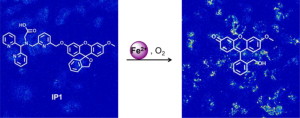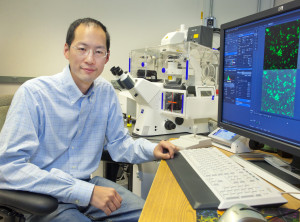
IPI is a fluorescent probe that can visualize changes in exchangeable iron stores in living cells upon iron supplementation or depletion.
You don’t have to listen to heavy-metal music to be a metal head. The human brain harbors far more copper, iron and zinc than anywhere else in the body. Abnormally high levels of these metals can lead to disorders such as Alzheimer’s and Parkinson’s diseases. Chris Chang, a faculty chemist with Berkeley Lab’s Chemical Sciences Division, has spent the past several years developing new probes and techniques for imaging the molecular activity of these metals in the brain. Speaking at the national meeting of the American Chemical Society (ACS) in San Francisco, he discussed challenges and recent achievements in this area of research.
“Brain physiology relies on unique inorganic chemistry not found elsewhere in the body,” Chang said. “Although it accounts for only two-percent of total body mass, it is the body’s most oxidatively active organ, consuming more than 20 percent of the oxygen we breathe. This high oxygen intake combined with the brain’s high content of copper and iron can lead to oxidative damage and subsequent neuronal death when levels of these redox-active metals rise and become misregulated.”

Chris Chang is a faculty chemist with Berkeley Lab and UC Berkeley, and an HHMI investigator. (Photo by Roy Kaltschmidt)
Chang, who also holds faculty appointments with the University of California (UC) Berkeley’s Chemistry Department and is an investigator with the Howard Hughes Medical Institute (HHMI), described a series of small-molecule fluorescent probes he and his group developed to safely image copper levels in living cells. Their first success was Coppersensor-3 (CS3), a probe that can be used to image labile copper pools in living cells at endogenous basal levels.
“We used CS3 in conjunction with synchrotron-based X-ray fluorescence microscopy (XRFM) to establish the first link between mobile copper and major cell signaling pathways,” Chang said. “Neuronal cells move significant pools of copper upon activation and these copper movements are dependent on calcium signaling.”
The most recent copper probe from Chang’s group is Coppersensor 790 (CS790), a fluorescent sensor that features near-infrared excitation and emission capabilities, ideal for penetrating thicker biological specimens.
“CS790 can be used to monitor fluctuations in exchangeable copper stores under basal conditions, as well as under copper overload or deficiency conditions,” he said.
For monitoring iron in the brain, Chang and his group have developed Iron Probe 1 (IP1), which enables researchers to monitor changes in natural cellular iron stores.
“IP1 is a new type of reaction-based turn-on fluorescent probe for monitoring exchangeable iron ion pools in aqueous solution and living cells,” he said. “It is sensitive enough to detect endogenous, basal labile iron pools and can identify and visualize expansions in these iron pools upon stimulation with either the hormone hepcidin or vitamin C.”
These and other probes being developed by Chang and his group will help provide a better understanding of the contributions by metals such as copper and iron to the functioning of the brain in various stages of health and disease.
“The brain offers a grand challenge for a molecular understanding of memory and senses such as sight, smell, and taste, as well as for developing new therapeutics for stroke, aging and neurodegenerative diseases such as Alzheimer’s and Parkinson’s,” Chang said.
Additional Information
For more information about the research of Chris Chang’s lab, visit his Website here.
